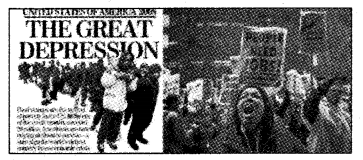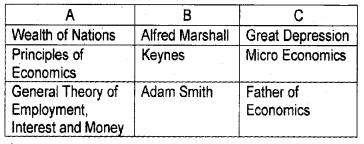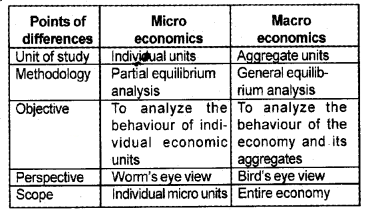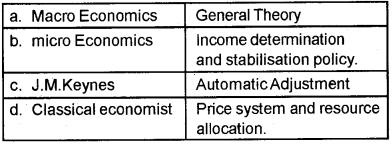Kerala Plus Two Macroeconomics Chapter Wise Questions and Answers Chapter 1 Introduction
Plus Two Economics Introduction Macroeconomics One Mark Questions and Answers
Question 1.
Give two examples for macroeconomic studies.
Answer:
- National income
- Aggregate employment
Question 2.
The expenses which raise productive capacity is known as
Answer:
(a) Consumption expenditure
(b) Investment expenditure
(c) Export expenditure
(d) None of the above
Answer:
(b) Investment expenditure
Question 3.

The pictures are related to the impacts of recession in 2008. Can you identify some impacts of the Great Depression of the 1930’s?
Answer:
Unemployment, Fall in Aggregate Demand, etc.
Plus Two Economics Introduction Macroeconomics Two Mark Questions and Answers
Question 1.
Categorize the following into micro and macroeconomics.
GDP, study of a firm, individual consumption, price of rubber, wholesale price level, total employment, production of coconut, total imports.
Answer:
| Microeconomics | Macroeconomics |
Study of a firm | GDP |
Question 2.
“Macroeconomics has got some limitations” Do you agree? Substantiate your answer.
Answer:
Yes, I agree.
Macroeconomics has got some limitations as pointed out below.
- The generalisation from individual experience may not be true for the aggregates.
- Aggregates are not homogeneous.
- An aggregative tendency may not influence all the sectors of the economy in the same manner.
- A study of the aggregates may lead us to believe that no new policy is needed and there is no change in the policy.
Question 3.
Name four sectors of the economy.
Answer:
Four major sectors of the economy are:
- firms
- households
- government
- external sector
Question 4.
List out any two features of a capitalist economy.
Answer:
Private ownership of the means of production. Production takes place for selling in the market.
Question 5.
Identify the sectors of the economy from the given below sentences.
- A subsidy is announced
- People buy more goods
Answer:
- Government
- Household
Question 6.
Some variables are given below. Classify them under two branches of economics.
- Utility
- GDP
- Inflation
- Demand for pen
- Aggregate Consumption
- Taxes
Answer:
Micro Economics
- Utility
- Demand for pen
Macro Economics
- GDP
- Inflation
- Aggregate Consumption
- Taxes
Plus Two Economics Introduction Macroeconomics Three Mark Questions and Answers
Question 1.
Prepare a note on Macroeconomics.
Answer:
Macroeconomics deals with the aggregate economic variables of an economy. It also takes into account various interlinkages which may exist between the different sectors of an economy. This is what distinguishes it from microeconomics, which mostly examines the functioning of the particular sectors of the economy, assuming that the rest of the economy remains the same.
Macroeconomics emerged as a separate subject in the 1930s due to Keynes. The Great Depression, which dealt a blow to the economies of developed countries, had provided Keynes with the inspiration for his writings. In this book, we shall mostly deal with the working of a capitalist economy.
Hence it may not be entirely able to capture the functioning of a developing country. Macroeconomics sees an economy as a combination of four sectors, namely households, firms, government and external sector.
Question 2.
Choose the appropriate answer
a. The Greek word‘macros’ means
- small
- large
- very small
b. Partial equilibrium analysis is the methodology of
- Microeconomics
- macroeconomics
- both microeconomics and macroeconomics
c. The words microeconomics and macroeconomics were coined by
- J.M. Keynes
- Ragner Frisch
- Adam Smith
Answer:
a. 2. large
b. 1. Microeconomics
c. 2. Ragner Frisch
Question 3.
Point out the significance of macroeconomics.
Answer:
The study of macroeconomics is important because of the following reasons
- It helps to understand the functioning of the economy
- It is helpful in comparison
- It is useful in planning
- It is helpful in studying growth and development
- It is helpful in studying economic fluctuations 0 It is helpful in formulating economic policies.
Question 4.
Match A with B and C.

Answer:

Question 5.
Below is given a few features of a phenomenon.
- Output and employment in the countries of Europe and North AmeruSft fell by huge amounts.
- Demand for goods was low.
- Factories remain idle.
- Identify the phenomena
- Name the book that explained a solution for this crisis.
- Identify the branch of economics emerged after this
Answer:
- The great depression of 1929
- General theory of employment, interest, and money.
- Macro Economics
Plus Two Economics Introduction Macroeconomics Five Mark Questions and Answers
Question 1.
Fill in the blanks.
- Macroeconomics, as a separate branch of economics, emerged after the British economist ………..
- The General Theory of Employment, Interest, and Money’ was written in The General Theory of Employment, Interest and Money’ ………….
- ‘General Theory of Employment, Interest, and Money’ was written byThe General Theory of Employment, Interest and Money’ ………………
- The Great Depression occurred in ……………
- Macroeconomics finds an economy as a combination of four sectors, namely …………………
Answer:
- John Maynard Keynes
- 1936
- John Maynard Keynes
- 1929
- Households, firms, government and external sector.
Question 2.
Find the odd one out. Justify your answer.
- Income of a family, production of rice, gross domestic saving, profit of a firm
- Price of rice, wholesale price index, total exports, inflation
- Partial equilibrium analysis, Entire economy, Individual units, Worm’s eye view
- Aggregate units, Worm’s eye view, Bird’s eye view, General equilibrium analysis.
Answer:
- Gross domestic saving. Others are microeconomic indicators
- Price of rice. Others are macroeconomic indicators
- Entire economy. Others are features of microeconomics.
- Worm’s eye view. Others are features of macroeconomics.
Question 3.
Arrange the following points as the features of microeconomics and macroeconomics and complete the table.

Answer:

Question 4.
Match the following

Answer:

Question 5.
Discuss the importance of macroeconomics.
Answer:
Importance of macroeconomics:
1. Information about the economy:
Macroeconomics provides insight into various interrelated aspects and the functioning of the economy.
2. Formulation of economic policy:
Macroeconomics plays a critical role in the formulation of economic policies.
3. Economic planning:
The main objective of economic planning is to implement various police and programmes for the welfare of the people on priority basis. Macroeconomic helps economists to examine the interrelationship between various macroeconomic variables and choose the programmes best suited for the welfare of the people.
4. Examine Economic fluctuations:
Macroeconomics examine various fluctuations in different variables such as national income, aggregate output, trade deficit, investment, etc.
